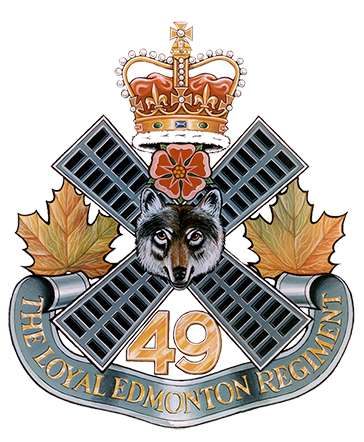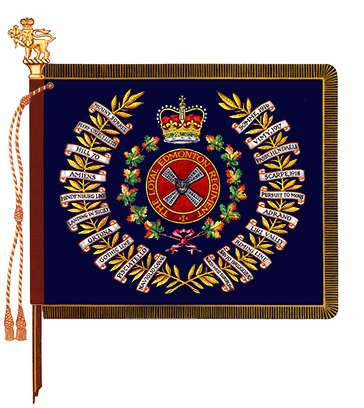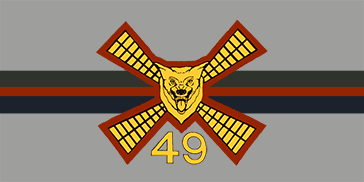The Loyal Edmonton Regiment (4th Battalion, Princess Patricia’s Canadian Light Infantry)
The official lineage of The Loyal Edmonton Regiment (4th Battalion, Princess Patricia’s Canadian Light Infantry) infantry regiment.

Badge
Description
On the sails of a windmill in saltire Sable between in chief a rose proper, in base the number 49 Or and in the flanks two autumnal maple leaves, a coyote's mask, the whole ensigned by the Royal Crown proper and resting on a scroll Sable inscribed THE LOYAL EDMONTON REGIMENT in letters Or.
Symbolism
The maple leaves symbolise service to Canada and the regiment's perpetuated units, the 51st and 63rd Battalions of the Canadian Expeditionary Force, and the crown, service to the Sovereign. The number 49 represents the service of the perpetuated unit, the 49th Battalion of the Canadian Expeditionary Force, and the windmill sails allude to the battlefields in Flanders on which the battalion fought in the First World War. The coyote's head commemorates "Lestock", a prairie coyote presented to the regiment as a mascot prior to the 49th Battalion's departure for overseas service in 1915. The red rose came from the badge of the former allied regiment The Loyal Regiment (North Lancashire) (now, through amalgamation, the Duke of Lancaster's Regiment). "THE LOYAL EDMONTON REGIMENT" is a form of the regimental title.
Motto
FEARS NO FOE
March
"Bonnie Dundee"
Alliance
British Army
Duke of Lancaster's Regiment
AFFILIATION
Princess Patricia's Canadian Light Infantry
Regimental colour

Camp flag

Battle honours
The First World War
MOUNT SORREL; SOMME, 1916; Flers-Courcelette; Ancre Heights; ARRAS, 1917, '18; Vimy, 1917; HILL 70; YPRES, 1917; Passchendaele; AMIENS; Scarpe, 1918; HINDENBURG LINE; Canal du Nord; PURSUIT TO MONS; FRANCE AND FLANDERS, 1915-18.
The Second World War
LANDING IN SICILY; Piazza Armerina; Leonforte; Agira; ADRANO; Troina Valley; SICILY, 1943; Colle d'Anchise; The Gully; Ortona; LIRI VALLEY; Hitler Line; GOTHIC LINE; Monteciccardo; Monte Luro; RIMINI LINE; Pisciatello; San Fortunato; Savio Bridgehead; Naviglio Canal; Fosso Munio; ITALY, 1943-1945; Apeldoorn; NORTH-WEST EUROPE, 1945.
South-West Asia
AFGHANISTAN
Lineage
This Reserve Force regiment originated in Edmonton, Alberta on 1 April 1908, when the '101st Regiment' was authorized to be formed.Footnote 1 It was redesignated: '101st Regiment "Edmonton Fusiliers"' on 1 March 1909;Footnote 2 and 'The Edmonton Regiment' on 15 March 1920.Footnote 3 On 15 May 1924, it was reorganized to form two separate regiments designated 'The Edmonton Fusiliers' (now the 'The South Alberta Light Horse'), and 'The Edmonton Regiment'.Footnote 4 It was redesignated: '2nd (Reserve) Battalion, The Edmonton Regiment' on 7 November 1940;Footnote 5 '2nd (Reserve) Battalion, The Loyal Edmonton Regiment' on 7 July 1943;Footnote 6 The Loyal Edmonton Regiment' on 1 November 1945;Footnote 7 'The Loyal Edmonton Regiment (3rd Battalion, Princess Patricia's Canadian Light Infantry)' on 19 October 1954;Footnote 8 and 'The Loyal Edmonton Regiment (4th Battalion, Princess Patricia's Canadian Light Infantry)' on 1 April 1970.Footnote 9 and in French, « The Loyal Edmonton Regiment (4e Bataillon, Princess Patricia's Canadian Light Infantry) » 12 August 1977.Footnote 10
Notes:
Upon redesignation as The Edmonton Regiment on 15 March 1920 (see above), it was organized as a five battalion regiment with the 1st Battalion (172nd Battalion, CEF) and 2nd Battalion (Edmonton Fusiliers) (9th Battalion, CEF) on the Non Permanent Active Militia order of battle and the 3rd Battalion (51st Battalion, CEF), 4th Battalion (63rd Battalion, CEF) and 5th Battalion (66th Battalion, CEF) on the Reserve order of battle.
The Edmonton Regiment was disbanded for the purpose of reorganization on 15 September 1920 and reorganized the same day (GO 253/20). This change was administrative and does not affect the lineage of the regiment.
Upon reorganization on 15 May 1924 (see above), The Edmonton Regiment was organized as a three battalion regiment with the 1st Battalion (49th Battalion, CEF) on the Non Permanent Active Militia order of battle and the 2nd Battalion (51st Battalion, CEF), and 3rd Battalion (63rd Battalion, CEF) on the Reserve order of battle. The reserve units were disbanded on 14 December 1936 (GO 3/37).
On 4 May 1951, the regiment mobilized two temporary Active Force companies designated "E" and "F" (CAO 110-2, Pt 'B', Supp Issue No. 245/51 and SD 1 Letter No. 4237, 5 May 1951). "E" Company was reduced to nil strength upon its personnel being incorporated into the '1st Canadian Infantry Battalion' for service in Germany with the North Atlantic Treaty Organization (SD 1 Letter No. 4365, 12 November 1951). It was disbanded on 29 July 1953 (CAO 78-2, Pt 'B', Supp Issue No. 352/53). "F" Company was initially used as a reinforcement pool for "E" Company. On 15 May 1952, it was reduced to nil strength, upon its personnel being absorbed by the newly formed '2nd Canadian Infantry Battalion' for service in Korea with the United Nations (SD 1 Letter No. 4452, 22 April 1952 and CAO 110-2, Pt 'B', Supp Issue No. 283/52). "F" Company was disbanded on 29 July 1953 (CAO 78-2, Pt 'B', Supp Issue No. 352/53).
Perpetuations
'49th', '51st' and '63rd "Overseas" Battalion(s), CEF'
Headquarters Location
Edmonton, Alberta
Operational history
The First World War
The 49th Battalion, which was authorized on 7 November 1914 as the '49th Battalion, CEF',Footnote 11 embarked for Great Britain on 3 June 1915.Footnote 12 It disembarked in France on 9 October 1915, where it fought as part of the 7th Infantry Brigade, 3rd Canadian Division in France and Flanders until the end of the war.Footnote 13 The battalion was disbanded on 15 September 1920.Footnote 14
The 51st Battalion, which was authorized on 7 November 1914 as the '51st Battalion, CEF',Footnote 15 embarked for Great Britain on 1 April 1916.Footnote 16 It provided reinforcements for the Canadian Corps in the field until 13 November 1916, when it was reorganized as a Garrison Duty Battalion.Footnote 17 On 22 June 1916, its personnel were absorbed by the various regimental depots.Footnote 18 The battalion was disbanded on 15 September 1920.Footnote 19
The 63rd Battalion, which was authorized on 20 April 1915 as the '63rd "Overseas" Battalion, CEF',Footnote 20 embarked for Great Britain on 22 April 1916.Footnote 21 It provided reinforcements for the Canadian Corps in the field until 7 July 1916, when its personnel were absorbed by the '9th Reserve Battalion, CEF'.Footnote 22 The battalion was disbanded on 1 September 1917.Footnote 23
The Second World War
The regiment mobilized 'The Edmonton Regiment, CASF' for active service on 1 September 1939.Footnote 24 It was redesignated: '1st Battalion, The Edmonton Regiment, CASF' on 7 November 1940;Footnote 25 and '1st Battalion, The Loyal Edmonton Regiment' on 7 July 1943.Footnote 26 On 22 December 1939, it embarked for Great Britain.Footnote 27 "D" Company participated in the expedition to Spitzbergen on 25 August 1941, and the battalion landed in Sicily on 10 July and Italy on 4 September 1943, as part of the 2nd Infantry Brigade, 1st Canadian Infantry Division.Footnote 28 The unit landed in France on 15 March 1945, on its way to the North West Europe theatre of operations, in which it fought until the end of the war.Footnote 29 The overseas battalion was disbanded on 15 October 1945.Footnote 30
On 1 June 1945, a second Active Force component of the regiment was mobilized for service in the Pacific theatre of operations, under the designation '3rd Canadian Infantry Battalion (The Loyal Edmonton Regiment), CASF'.Footnote 31 The battalion was disbanded on 1 November 1945.Footnote 32
South-West Asia
From 2002 to 2014, The Loyal Edmonton Regiment (4th Battalion, Princess Patricia’s Canadian Light Infantry) augmented various CAF units deployed to Afghanistan.Footnote 33
Page details
- Date modified: